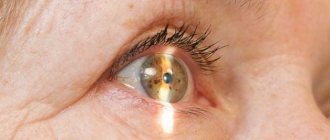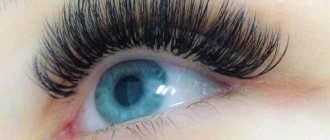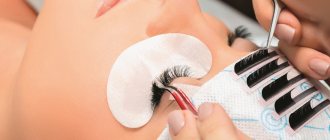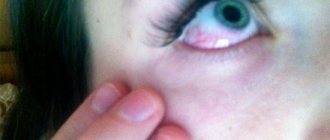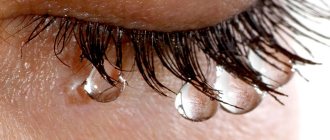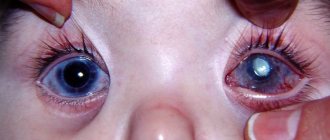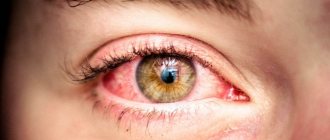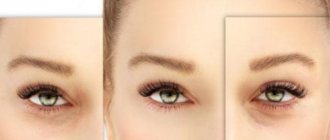The best eye drops for eye burns: types and properties
Eyes are the most sensitive human organs to external influences. Any aggressive contact of the delicate eye structures with chemicals, steam, hot objects, fire, ultraviolet radiation leads to severe damage and often to dire consequences. Therefore, it is important to know how to protect the organs of vision and how to provide first aid for various types of eye burns.
Causes and classification
Mostly, the eyes suffer from chemical and thermal burns, since almost all people daily interact with household chemicals, which include various chemicals. Careless handling of plumbing cleaners or laundry detergents can result in chemical burns. And thermal damage can easily occur during careless cooking. Drops of hot oil or fat or steam entering the mucous membrane of the eye cause a thermal burn. Radiation injury is much less common.
Depending on what caused the burn, the following types of lesions are distinguished:
- Thermal. They develop as a result of exposure to high temperatures due to hot splashes of fat entering the eye during cooking, exposure to steam, sparks from fireworks, etc. The skin of the eyelid, conjunctiva, and cornea are more often injured from thermal effects, and burns to deeper ocular structures are less likely to occur.
- Chemical. Similar damage is caused by alkalis and acids. Lead to the death of cells that are directly exposed. Among the acids that most often injure people's eyes, they are sulfuric, hydrochloric and acetic acids. They are part of many household chemicals. When affected by acid, the protein in the eye mucosa curls up and prevents the chemical from penetrating into the deeper layers. Alkalies penetrate into the ocular structures, destroy cells and contribute to the development of wet necrosis. They differ in the duration of action of the damaging substance. It gradually penetrates through the superficial tissues from the site of damage to the deeper layers. Among alkalis, burns are most often caused by potassium, magnesium, sodium hydroxide, lime, and ammonia.
- Radiation. Caused by prolonged or sudden exposure of the eyes to ultraviolet (short-wave) or infrared (long-wave) rays. The damage is called electroophthalmia. Ultraviolet light causes burns to the skin, cornea, and conjunctiva. Long waves easily penetrate the cornea and injure the retina. Ultraviolet burns can occur as a result of abruptly leaving the dark into a brightly lit place or while observing a solar eclipse without appropriate protection. Most often, long-wave rays injure the eyes of people working with welding.
Anatomical features of the structure
There are several constituent layers in the cornea:
- outer epithelial;
- anterior border (Bowman's membrane);
- stroma;
- Descemet's layer;
- epithelial layer.
The outer surface of the cornea is an extension of the connective membrane of the eye, its layers consisting of multilateral non-keratinized cells. Basal epithelia are cylindrical.
Corneal cells are characterized by high regeneration abilities. Scientific research has shown that any degeneration of the membrane is restored with lightning speed due to the proliferation of the epithelium of the surface film. The level of regeneration is so high that even with complete damage to the epithelium, recovery occurs within three days.
Under the outer epithelial layer there is a homogeneous, non-structural Bowman's tissue; it is a hyalinized facet of the base (individual element of the cornea) with a similar chemical composition. Near the extreme areas it becomes thinner and ends within a radius of one millimeter from the end of the horny layer.
The base occupies the largest area of space. Consists of alternating connective tissue layers with processes of many fibrils. The fibrils contain sulfohyaluronic acid, which ensures the transparency of the cornea.
Important! The cornea does not contain blood tubules: the surface layers are equipped with marginal choroid plexuses and lymph nodes. Metabolic processes in the structure are carried out due to the extreme looped networks, tear fluid and natural moisture in the anterior epithelial layer of the cornea.
Symptoms
When eye burns occur, tissue cells die, causing blood clots to appear in the capillaries, and plasma leaks into the surrounding tissues.
All types of burn injury are accompanied by similar symptoms:
- swelling of the cornea, conjunctiva;
- severe pain in the eye;
- redness of the skin of the eyelids and eyeball;
- photophobia;
- changes in visual fields;
- lacrimation;
- increase or decrease in eye pressure;
- decreased visual acuity;
- corneal clouding;
- blepharospasm, in which it is difficult to open the eyelids.
Provoking factors
We list several reasons that can negatively affect the condition of the eyeball:
- Acid or alkali contact with the area around the eyes.
- Careless handling of varnish or paint.
- Using decorative cosmetics for eyelashes that contain aggressive components.
- Careless handling of aerosols and personal products.
- Violation of safety rules at work.
- Instilling a solution not intended for this purpose into the eyes.
- Contact of alkali on the mucous membrane as a result of inept handling.
- Poor quality incendiary mixture.
- Improper handling of firecrackers or fireworks.
First aid
In case of eye burns, it is important to provide first aid to the person as quickly as possible. The preservation of vision often depends on this.
First aid boils down to the following:
- removing residual damaging substances using a sterile cotton swab;
- rinsing the eyes with clean water or saline solution from a large syringe for 15 minutes (if the burn is caused by an alkali, rinsing is carried out with a 2% boric acid solution. When exposed to acids, a soda solution is used for rinsing);
- instillation of a solution of novocaine, lidocaine (4%) or Levomycetin (0.2%). You can use Acetopt, Sofradex. It is better to perform the procedure in a darkened room, as instillation is very painful.
Drug groups
Therapeutic measures for all types of burns are quite similar, only the doses and duration of the therapeutic course differ depending on the degree of damage to the eye structures.
The main groups of drugs that are used for burn injuries to the eye are shown in the table.
| Drugs. | The action provided. |
| Anesthetics (Lidocaine, Novocaine). | Eliminate pain syndrome. |
| Local antibiotics (Levomycetin, Lincomycin drops, Sulfacyl). | Prevent inflammation. Help minimize the risk of infection of the affected organ. |
| Artificial tear preparations (Vizin). | In case of a burn to the mucous membrane of the eye, these drops are necessary to moisturize and protect the damaged organ. |
| Antihypertensives (Ganford, Dorzolamide, Betaxol). | Reduce eye pressure. |
| Mydriatics (Atropine, Ephedrine). | Needed for normal pupil dilation and normalization of the iris. |
| Cytoplegic (Scopolamine). | Designed to relieve pain symptoms and prevent adhesions. |
| Glucocorticoids. (Dexamethasone, Betamethasone, Cortisone). | Prescribed for extensive or deep burns to eliminate redness, burning, swelling and swelling of the eyelids. |
| Anti-inflammatory (Naklof or Diklo-F). | Such drops for eye burns are necessary for the regeneration of damaged tissues. |
Drops recommended for different types of burns
For any type of burn, it is important to relieve pain and prevent infection from entering the affected tissue.
For thermal burns
For thermal damage, the following drops can be used:
- Inocaine. The active substance is benoxynate hydrochloride. Local anesthetic that blocks nerve endings.
- Visoptician. Eliminate photophobia, itching, burning, lacrimation, swelling.
- Okomistin. An antiseptic that forms a protective film on injured tissues.
- Prokulin. Relieves swelling, pain, has a vasoconstrictor effect.
As part of complex therapy for burn damage to the eyes, Emoxipin is prescribed, which helps restore energy metabolism in tissues and accelerates their healing, strengthens blood vessels, restores blood circulation, and stimulates regeneration processes.
For radiation burns
Radiation burns are treated with the following drops:
- Corticosteroids. Hydrocortisone, Dexamethasone, which help eliminate local swelling.
- Lidocaine. The solution contains sodium chloride and benzalkonium, lidocaine hydrochloride. Prescribed for eye burns to reduce tissue sensitivity.
- Derinat. Drops with an immunomodulatory effect. They help quickly regenerate injured areas, preventing the appearance of scars.
- Phloxal. Drops with antibacterial action. Prevents infection of damaged tissues.
- Tsiprolet. Antimicrobial drops for a wide range of applications. In case of eye burns, they are instilled 5 times a day, 2 drops into each eye.
- Levomycetin (active ingredient chloramphenicol) acts against most gram-positive and gram-negative bacteria.
Drops for chemical burns
A 1% solution of Dicaine helps with eye burns of chemical origin.
This is a local anesthetic that contains sodium chloride and leocaine, which reduces the sensitivity of sodium channels through which pain impulses are transmitted. Drops reduce pain and have a local anesthetic effect. Atropine is used. The active ingredient of the drops is atropine sulfate. Helps relieve pain and prevent adhesions.
Ciprofloxacin also helps, which has anti-inflammatory and antibacterial effects.
Medicinal treatments
Professional medical care for complicated burn injuries consists of emergency care, treatment and rehabilitation of the consequences of burn complications.
Emergency medical support consists of preliminary treatment: rinsing the fundus with furatsilin solution or any other neutral liquid. Washing is carried out for at least half an hour. If possible, when washing, it is advisable to turn out the eyelid area.
At first, there is a constant increase in pain; to relieve pain, an anesthetic is instilled into the eye area. All foreign particles from the conjunctival area are removed. In case of chemical damage, the eyes are washed with neutral liquids. To prevent secondary infection, antibiotics are prescribed in the form of eye drops or gels.
Inpatient treatment is aimed at creating optimal conditions for tissue regeneration. Copious, repeated rinsing of the eyes is prescribed; 0.5 ml of hemodez is infused daily under the membrane of the conjunctiva and fornix for seven days. Autoserums, antibiotics, antispasmodics, and anticoagulants are injected into the area of the conjunctival membrane.
To increase trophic properties and tissue regeneration, drip infusions with a suspension of quinine dihydrochloride, glucose and riboflavin preparations are prescribed. A tetracycline application is placed in the eyelids, subconjunctival injections with antibiotics, desensitizing agents, and NPS are prescribed.
Forecast
The prognosis for a person who has received an eye burn will depend on timely treatment. Most superficial burns disappear without a trace. Moderate and severe damage is fraught with scarring of the eyelids, the development of cataracts, and death of the eyeball. Radiation damage affecting the retina often leads to vision loss.
Author of the article: Bakhareva Elena Sergeevna, specialist for the website glazalik.ru Share your experience and opinion in the comments.
If you find an error, please select a piece of text and press Ctrl+Enter.
source
Antibacterial drops
If you receive a burn as a result of exposure to welding, then most likely inflammation has begun. This means the use of antibiotics will be required. But they must be in shape. Which will allow you to apply them topically, directly to the affected area.
The most famous drops with an antibacterial effect:
- Tobrex;
- Oftaquix;
- Gentamicin;
- Dexamethasone;
- Taufon or Taurine.
The mechanism of action of antibacterial drugs is to block the formation of bacterial proteins by binding to bacterial ribosomes.
Method of application: by introducing drops onto the conjunctival sac. The dose of use always depends on the severity of the condition, but the usual dosage is:
- For infections with moderate symptoms, antibacterial eye drops after welding are used in the amount of 1-2 drops with an interval of 4 days;
- For infections with symptoms of high severity, it is recommended to reduce the interval of drug administration - 1-2 drops every hour;
- Antibacterial drops can be used for a course of no more than 2 weeks.
Contraindications for use:
- Intolerance to components;
- Infancy (less than 1 year);
- Severe kidney pathologies;
- Pregnancy and breastfeeding;
- Myasthenia;
- Acoustic neuritis.
Important: long-term use of antibacterial eye medications beyond 2 weeks can lead to fungal or secondary bacterial infection. Side effects:
Side effects:
- Reaction to light in the form of a spasm;
- lacrimation;
- Burning and itching;
- Development of bleeding of mucous membranes;
- Hallucinations.
Important: before using eye drops after welding, contact lenses must be removed.
Eye burn. What is this?
What is an eye burn? This is damage to the eyelid, cornea or conjunctiva, as well as its structure when exposed to chemicals, burns due to high temperatures or exposure to certain types of rays. Often, many people do not even realize that they have suffered an eye injury, since they do not have any special symptoms other than those that can be considered an allergic reaction or infection. In order to eliminate the problem in time and not suffer from more serious ones in the future, and to have time to seek medical help, it is important to know about the types of burns and their brief characteristics.
What are the types of eye burns?
Ophthalmologists offer the following classification of eye burns.
- Thermal, which can appear from exposure to extremely high or, conversely, low temperatures. For example, fire, steam, liquefied gases. This type of eye burns is usually localized in the anterior parts of the eye, most often without damaging their deep parts.
- A chemical burn can occur when the visual organ is exposed to caustic alkalis, acids, iodine, ammonia, lime, household chemicals or cosmetics. Such an eye burn is very prolonged in its effect, so it can damage the deepest layers of the retina. Looking ahead, let's say that drops for this type of burn should be used only after consultation with a doctor.
- Radiation burns of the cornea most often occur due to short-wave penetration of ultraviolet rays or infrared radiation. You can get it when visiting a solarium or ski resorts. A corneal burn appears after four to six hours and is characterized by severe pain, photophobia, lacrimation and decreased clarity of vision.
Degrees of burns
Ophthalmologists distinguish the following degrees for burns of the cornea of the eye, which are important to know about: first, second, third and fourth.
With the first, there is often an eye burn and corneal erosion, but only superficial. You can avoid deterioration of vision and other unpleasant consequences if you immediately consult a doctor.
In addition to damage to the tissue of the eyelids, their death and swelling, the second degree is characterized by the appearance of burn blisters. Damage to the surface and stroma of the cornea is also possible.
The third degree leads to consequences such as necrosis of the sclera and cartilage. The conjunctiva turns yellow, the cornea becomes cloudy, and its surface becomes dry. With such an injury, people often face not only cataracts, but also glaucoma. The eye is injured up to 50%.
There is also a fourth degree burn, in which severe tissue death and necrosis occurs. In addition to the above consequences, corneal perforation often occurs.
Let's talk about the symptoms of burns. Please note that you should not diagnose a burn of the ocular cornea on your own, as well as prescribe medications and treatment - you can only harm the body. Below we will describe possible symptoms, if you find that you have them, you need to immediately make an appointment with a specialist.
All degrees of burns are characterized by severe pain and hyperthermia. If the burn is received during heat treatment, the symptoms are as follows: the eyelids are tightly compressed, the upper shell of the cornea is affected. If the burn is chemical, then the patient is overcome by cutting pain, blepharospasms, deterioration in clarity of vision up to loss of vision, and lacrimation. In addition, the cornea of the eye may become cloudy or yellowish. Often people observe the appearance of tumors.
How is the diagnosis done?
The primary diagnosis is made based on clinical signs. This happens because it is necessary to immediately provide assistance to the patient. What can be the examination of the eyeball and cornea of the eye in case of a burn? First, the specialist measures the pressure, then identifies violations of the integrity of the structure of the skin, cornea and film layer. Biological microscopy is performed, which allows us to determine what is happening with the conjunctiva, cornea and other parts of the eye at the moment. Then the ophthalmologist carefully examines the central parts of the eyeball. And only after this detailed study can the ophthalmologist give a conclusion about the presence or absence of a burn, its degree and describe detailed treatment.
If you suddenly receive an eye burn and are not yet sure what degree it is and how badly the organ is injured, immediately call an ambulance or go to the doctor. At the same time, ophthalmologists say that under no circumstances should you use napkins, wipe your eyes and face with clothing, or touch your eyes with your hands. Also, you should not resort to hot compresses and rinse the retina with tap water or any other. Compliance with these rules will help avoid infection and further aggravation of the situation. And, of course, do not use medications containing substances that can cause irritation.
Consequences of damage to the cornea of the eye
A burn to the cornea or retina is a dangerous phenomenon that leads to serious consequences. According to ICD 10 (international classification of diseases) it is considered under code T26.
With such lesions, the cornea and most of the eye are affected. In severe forms of burns, without immediate assistance, a person may encounter the following problems:
- tissue scarring;
- change in the shape of the eyeball;
- partial or complete clouding of the cornea;
- blockage of the tear ducts;
- fusion of eyelids;
- violation of the location of the eyelid;
- changing the direction of eyelash growth;
- cataract;
- inflammatory processes;
- increase in eye pressure;
- acquisition of pathological diseases;
- organ removal;
- loss of vision.
A burn with hydrogen peroxide at a concentration of 3% leads to disruption of the structure of the cornea. High concentrations of peroxide can cause deep damage, including loss of vision. Consequences may arise as a result of quartz firing.
Lack of timely assistance leads to aggravation of the situation. Without the necessary medications, the patient risks getting a bacterial infection, which is dangerous due to inflammation of the affected area, but also sepsis.
Deep forms of burns and further complications can lead to irreversible processes, as a result of which a person needs to undergo prosthesis installation or plastic surgery.
We recommend reading:
The dangers of each degree of chemical eye burns
Eye drops for burns. Treatment
Regardless of the type of eye burns, it is first necessary to eliminate the damaging factor (radiation, chemical substance, temperature exposure). If you are unable to immediately call an ambulance, then you should immediately go to a dark room and apply a sterile cold compress and drink a painkiller. But again, doctors need to be called as soon as possible to determine the severity of the disease and the correct assistance provided. As mentioned above, a corneal burn is associated with tissue dryness, so you cannot do without moisturizing eye drops. But only a doctor can prescribe them, based on the patient’s condition.
So, what kind of eye drops are there? What are they used for? To treat burns, it is recommended to resort to drugs such as Atropine or Scopolamine, which not only minimize pain, but also reduce the risk of adhesions. To avoid the development of infections and the proliferation of bacteria in the affected eye, drops with an antibacterial effect should be used. For example, Tetracycline eye drops or Levomycetin ointment. Also, doctors often administer injections (with full treatment) with antioxidants, which speed up the healing process of the cornea. As a result of the injury, there is an increase in intraocular pressure. To reduce it, use local antihypertensive drugs. These include eye drops “Betaxopol” and “Dorzolamide”.
In case of a thermal burn, after washing the eyes with cold water, it is recommended to use eye drops for the burn. The best ones are those that contain panthenol, which will take care of tissue restoration, and chondroitin sulfate for hydration and healing. Recently, drops for eye burns from Japanese manufacturers have become very popular. These include: Rohto V, Sante 40 Gold or Sante Medical Guard. Experts often prescribe drops for corneal burns such as Okomistin, Lecrolin, Vitabact and Diclofenac, which also help relieve pain and promote rapid healing of the organ, as well as its maximum hydration. This, as noted above, is extremely important in this rehabilitation therapy. Ophthalmologists often say that after using eye drops for a burn, you should apply compresses with ointments. For example, “Levomycetin” or “Levomekol”. If you have a chemical burn to the eye, then, first of all, you need to apply a bandage over your eyes, but it must be sterile. If you receive a radiation burn, it should be treated exclusively in a hospital and after a thorough examination. It is extremely important here how deep the defeat was. For severe burns (third and fourth degrees), ophthalmologists resort to drugs such as Dexamethasone and Betamethasone. During the rehabilitation process, a visit to a physiotherapy office is often prescribed. In emergency cases with severe eye damage, surgery is indicated. If a patient has a fourth-degree chemical burn, corneal paracentesis is often performed. During the operation, fragments of necrotic tissue are removed. Surgery is necessary for scars that appear on the surface of the eye.
If you follow safety precautions, you can almost always avoid any burn. To do this, it is necessary to handle chemicals extremely carefully and use personal protective equipment when performing all kinds of work. Keep in mind that an eye burn is a particularly dangerous injury, so contact an ambulance immediately if you feel discomfort or realize that you have a burn. In this case, as in many others, it is not recommended to self-medicate, as you may lose your vision once and for all. Get emergency medical attention for yourself or others.
source
What can you put in your eyes after welding?
Welding is a dangerous and responsible process that must be carried out in compliance with the required rules. The work must be carried out by a specialist with extensive experience who must know the necessary safety principles. Even the slightest violation can be very fraught with health consequences; the organs of vision can be especially affected.
For this reason, you need to know what to put in your eyes after welding. This will help prevent dangerous consequences. But still, if the symptoms do not disappear for a long time, then it is better to consult a specialist.
How to detect eye damage
During the welding process, safety must be observed, so many experienced specialists use special personal protective equipment - clothing made of thick fabric, a face and eye mask, and gloves. Otherwise, the sparks that are released during welding of metal products can get into your eyes and cause serious harm.
It is worth noting! If the damage is not severe, the technician does not immediately experience unpleasant sensations, and they are usually not pronounced. Symptoms of eye burns often do not appear until 3-5 hours later.
Before you find out what you can put in your eyes after welding, it’s worth considering the nature of the symptoms. To begin with, it is worth studying the degree of damage, which is accompanied by certain signs:
- A superficial or mild burn occurs during brief exposure to bright ultraviolet radiation. Unpleasant signs appear within 5-7 hours. First, a slight redness of the white forms, followed by a burning sensation. When looking at the light, pain is felt, and the cornea gradually becomes cloudy. If no other signs appear in the future, treatment can be performed at home.
- In moderate cases, painful sensations in the eyes are noted. Photophobia develops, and a person experiences unpleasant sensations when looking at light. I can’t even look at the phone screen without pain, my eyes turn red, and there is severe tearing. In this case, you should definitely visit an ophthalmologist. If the second degree is confirmed, the doctor will prescribe medications and send you home.
- A third degree injury is considered serious and requires immediate medical attention. To reduce discomfort, drops with an analgesic effect can be instilled into the eyes, but they will only help temporarily eliminate unpleasant feelings. Usually the same symptoms are observed as in the first two cases. Additionally, whitening of the cornea appears, nagging painful feelings that can be all over the face, they can radiate to the temple area. In addition, swelling of the eyelids will be noted.
- The fourth degree is the most severe and dangerous; you must visit a doctor very quickly, otherwise you may completely lose your vision. In this situation, damage is noted not only to the cornea, but also to the retina. The process of tissue death begins and partial necrosis develops. Often this can only be corrected by surgery. Usually there is severe pain with a cutting character, preventing you from opening your eyes.
First aid
It is important to know how to numb the eyes after welding; this will help significantly alleviate the condition and prevent the development of complications. But still, do not forget that it is better to immediately visit an ophthalmologist after relieving severe pain; he will be able to determine the extent of the damage and select the most suitable drops for treatment.
Below are a number of recommendations that will help get rid of the negative effects of the eyes after welding work:
- At the initial stage, a washing procedure is carried out. How to wash your eyes after welding? To do this, you can use a large amount of boiled water; a solution of potassium permanganate with a low concentration is also suitable;
- if there are small metal pieces in the fundus, they can be removed using a cotton swab, which is pre-moistened with water. If this method does not help eliminate foreign particles, then they can be cleaned with tweezers;
- Then you can drop Lidocaine into your eyes after welding, it will help numb the cornea. It is recommended to use a two percent solution. But this remedy should be used as a last resort if there is severe pain;
- After cleansing the fundus of the eye, it is necessary to place an ointment with an antiseptic effect under the eyelid area. Tetracycline ointment helps;
- It is necessary to take anti-inflammatory and analgesic medicine. For eye burns, you can use Analgin, Ketorol, Diclofenac;
- Apply a cold compress to the surface of the eyes. It will alleviate the condition from the moment when painkillers begin to act.
Important! Even if after the actions taken the condition improves significantly and becomes easier, you should still consult an ophthalmologist. The doctor will perform hardware diagnostics, he will be able to identify deviations from the norm, and select the most effective and correct treatment therapy.
What drops help after welding
Treatment at home can be carried out for mild burns. For example, when you “caught bunnies”, but there is a slight burn. If swelling, increased tearing, clouding of the cornea and other dangerous conditions are observed, then it is better to immediately visit a doctor.
But you still need to consider what to put in your eyes after welding at home. There are various types of drops that can quickly get rid of unpleasant symptoms after welding. But still they are divided into groups depending on the type of impact.
Painkillers
If your eyes hurt from welding, then you need to know what to put in them to eliminate the discomfort. First of all, it is recommended to use drops with an anesthetic effect; they can relieve severe discomfort and reduce inflammation.
Sometimes the pain is so severe that the victim is unable to even open his eyes. Along with this, increased tearing and photophobia occur.
So how can you numb your eyes after welding at home? The following drops are commonly used:
- Lidocaine;
- Tetracaine;
- Alcaine.
These drops are considered the most famous, which are used as part of pain therapy.
But many people often ask whether it is possible to drip Novocain into the eyes after welding? This remedy also has an analgesic effect, it reduces discomfort and significantly alleviates the condition.
For this reason, it is excellent for suppressing unpleasant visual sensations immediately after welding work.
The action of all anesthetic drops is based on blocking voltage-dependent channels. This does not resist the formation of impulses in nerve endings and prevents them from being carried along nerve fibers.
It is recommended to use eye anesthetic after welding in accordance with the instructions. Usually 1-2 drops are instilled into the conjunctival sac. The effect may not last for a long period; after about 3-5 hours, unpleasant sensations may appear with renewed vigor.
Note! Lidocaine, Alcaine, Tetracaine, Novocaine in the eyes after welding should not be used too often. These products should be instilled no more than twice a day.
Vasoconstrictors
Drops with a vasoconstrictor effect are used after using painkillers. They will be able to eliminate a number of unpleasant phenomena:
- eliminate swelling;
- relieve redness;
- suppress the inflammatory process;
- relieve burning, itching.
If you don’t know how to soothe your eyes after welding, then drugs with a vasoconstrictor effect would be a suitable option. They are based on adrenergic agonists, they affect the receptors of the vascular walls. They cause the blood vessels to constrict, so there is relief from the symptoms of the disease.
Drops with a vasoconstrictor effect are highly effective, but they are not recommended for use for too long. Otherwise, they may have the opposite effect.
Any anti-welding eye vasoconstrictor should be used for no longer than 5 days. If it is used longer than this period, addiction may develop, and eventually there will be an increase in the symptoms and conditions that needed to be eliminated.
So what can you put in your eyes after welding? Among the popular drops with a vasoconstrictor effect are:
- Visine.
- Okumetil.
- Polynadim.
- Octilia.
- Naphthyzin.
- Alomide.
The drops are then used by instillation onto the conjunctiva. The dosage should be about 1-2 drops, and should be used 2 to 4 times per day. If you have contact lenses, they must be removed before using the medicine, and they can only be put on half an hour after instillation.
Important! The maximum period of use of vasoconstrictor drops should be 4 days. If there is no improvement after two days, it is better to stop using them.
When using drugs with a vasoconstrictor effect, side effects may occur:
- arrhythmia;
- decrease or increase in blood pressure;
- decreased body temperature;
- manifestation of cold sweat;
- pulmonary edema;
- if the drops are used for a long period, an increase in the symptoms of the disease may be observed.
Antibacterial
If an eye burn occurs during welding, inflammation will likely develop. In this case, the use of antibacterial agents will be required. But the form of antibiotics must be for topical use, the product must be applied to the affected area.
So what should you put in your eyes after welding? The following drops with antibacterial properties have a good effect:
- Tobrex.
- Oftaquix.
- Dexamethasone.
- Gentamicin.
- Taufon.
- Taurine.
Taurine or Taufon drops are often used after welding. These products have a strong antibacterial effect, they are found in any pharmacy and are sold without a prescription from a doctor.
Antibacterial drops are used by injection into the conjunctival sac. The dosage of the drug depends on the degree of damage:
- during an infection with moderate symptoms, drops with antibacterial properties are instilled 1-2 drops onto the conjunctival sac. The interval should be 4 hours;
- if infections with symptoms of high severity are observed, then you need to instill 1-2 drops into the conjunctival sac. The interval between instillations is reduced to 1 hour.
The course of application should be no more than two weeks, but only if improvements are noted. If the drops are used longer than this period, this may lead to the development of a fungal or secondary bacterial infection.
Drops for rapid regeneration
At the initial stage, drops should be used to eliminate pain, relieve inflammation and other unpleasant symptoms. Afterwards, you should use products to speed up the recovery of damaged tissue.
Note! Drops for rapid regeneration should be used in small courses. They will be able to restore damaged areas, and the body will not become accustomed to these drugs.
What can you drop into your eyes after welding to speed up the process of repairing damaged tissue? Consider the drops that many ophthalmologists recommend:
- Emoxipin . The action of the drug is aimed at resolving hemorrhages, restoring damaged skin, strengthening the structure of blood vessels;
- Derinat . The drops are great for treating severe eye burns. When used, rapid restoration of damaged mucosa occurs, they prevent the formation of scars;
- Vitasik . The drug has a general effect. It has an effect on the mucous membrane and restores nerve endings.
The use of folk remedies
When considering what you can drop into your eyes after welding, do not forget about folk remedies. They can be used independently, but you should still consult your doctor first. It is better to use for mild damage, because they certainly will not help for moderate and severe damage, and sometimes they can even cause complications.
So what should you put in your eyes after welding? At home you can use homemade drops and lotions:
- Potato . You can make a mask from the tubers; it will relieve pain and relieve swelling. Raw potatoes should be rubbed through a fine grater. The resulting pulp should be placed in gauze, wrapped and applied to closed eyelids. You need to keep it for 30 minutes.
- Linden tea . This remedy relieves swelling, redness, burning sensation, and itching. For cooking, it is better to use bags of raw materials. They should be brewed first and then applied to the eyes.
- Aloe . This plant has strong medicinal properties. The juice should be squeezed out of the leaves and mixed with natural honey. This combination must be instilled into each eye, 1 drop.
What not to do
It’s not enough to know what to put on your eyes after welding; you also shouldn’t forget about prohibited activities. This will help to avoid unpleasant consequences in the future.
Basic prohibited recommendations:
- In no case should you rub your visual organs too hard;
- no need to rinse your eyes from the tap;
- immediately after receiving damage there is no need to use folk remedies;
- Is it possible to put Lidocaine and other drops into the eyes after welding? It is better not to do this; you should first consult a doctor.
If after welding there are unpleasant feelings in the eyes, pain, swelling, then you should immediately consult a doctor. However, it is not always possible to quickly visit an ophthalmologist; in this case, first aid must be provided.
If severe pain is noted, you can drip Novocaine for the eyes after welding. This will alleviate the condition, but for a few hours.
And you definitely need to get to an ophthalmologist as soon as possible, only he will be able to determine the extent of the damage, and then select the most appropriate treatment.


